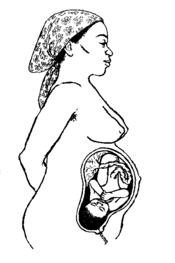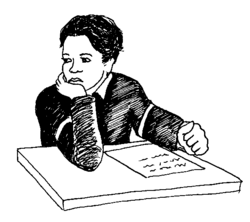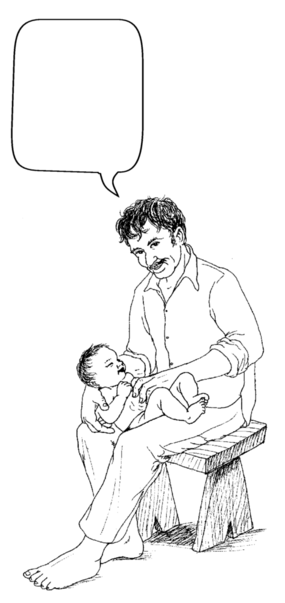Hesperian Health Guides
How Chemicals Harm Children
HealthWiki > A Community Guide to Environmental Health > Chapter 16: Harm from Toxic Chemicals > How Chemicals Harm Children

|
| Because children’s bodies are smaller, amounts of toxic chemicals that might not harm an adult can cause serious harm to a child. |
- Young children are closer to the ground and are more likely to eat, breathe, or touch chemicals that drift close to and collect on the ground.
- Children breathe much faster than adults and can get sick more easily from air pollution.
- Children often put their hands, toys, and other things in their mouths, and so are more likely to eat things that will harm them.
- Some parts of the body that protect adults from toxics are not yet well-developed in babies and children.
- When a baby’s organs are developing, they are more vulnerable to damage from chemicals.
Contents
Toxics at different stages of children’s growth

When the body is growing and changing quickly — during infancy, childhood, and adolescence — even very small amounts of chemicals can cause long-lasting and harmful changes in children’s bodies.
Before conception
If the reproductive systems or genes of the mother or father are harmed by chemicals, babies can be affected even if the exposure happened before the baby was conceived.

In the womb
Chemicals already in the mother's body can be passed to a developing baby during pregnancy. For example, a woman who was exposed to lead as a child may still have lead in her bones. When she is pregnant, the lead is passed to the baby in her womb.
Many toxic chemicals that a pregnant woman may be exposed to, such PCBs, lead, mercury, and insecticides can pass through the placenta into the growing fetus and cause harm.
Cigarette smoke, drugs, and alcohol can also harm a baby in the womb and should be avoided during pregnancy as well.
Birth to 2 years
 |
| Breast is best! |
A baby's skin and digestive system allow more chemicals to pass into the baby's body.
Some chemicals that a mother is exposed to can also collect in her breast milk and pass to the baby during breastfeeding. Toxics can also pass to babies in contaminated water used to mix formula and artificial milks. Breast milk is still the best food for a baby. Instead of avoiding breastfeeding to keep harmful chemicals out of babies, women are organizing to keep toxic chemicals out of breast milk.
Infants and toddlers put everything in their mouths. This makes it easy for them to swallow harmful substances.
2 years to 12 years
 |
| Children exposed to toxics may learn slowly, be irritable and restless, or show other signs of slow development. |
When children begin going to day care (creche) or school, they may be exposed to many new chemicals, for example, if their schoolyards are sprayed with pesticides. Children who work shining shoes, scavenging through waste dumps, or in other ways to make money are often exposed to toxic chemicals. Besides causing illness, toxics can also harm a young person's ability to learn.
12 to 18 years old
Adolescence (teen age) is a time of fast physical growth and change caused by hormones. Toxic exposures can seriously harm a young person's ability to have healthy children later.
Birth defects
Birth defects are caused by damage to a person’s genes. Because genes are passed from parents to children, harm from toxic chemicals may affect not only the person exposed to a toxic, but that person’s children and the children’s children. Not all birth defects are caused by toxic chemicals, but birth defects are more common in areas where industry uses or produces toxic chemicals or wastes. Birth defects can take many forms, some very mild (such as a birth mark) and others very severe (such as when the brain does not grow).

If your child is born with birth defects
If your child is born with birth defects, you may feel overwhelmed and uncertain about how you will care for your child. You are not alone!
Recognize your emotions. Parents experience shock, denial, grief, and even anger. Allow yourself to mourn the loss of the healthy child you thought you would have. Talk about your feelings with people who can understand and support you.
Seek community support. Ask your health worker or a social worker if they know other parents in the area who have children with the same condition. Join or start a support group with other parents. You and your child may discover a large and caring community.
Celebrate your child. Remember to let yourself enjoy your child the same way any parent would — by cuddling, playing, and watching the child grow and develop in his or her own way. Share your joy with family and friends.
Learn with your child. Seeking information about birth defects can be empowering, as can experiencing the changes the child goes through as he or she grows.
Physical exercises may help. Many disabilities can improve with the use of exercises and other methods. (To learn about physical exercises and other ways of helping children with birth defects and other disabilities, see the Hesperian books Disabled Village Children, Helping Children Who Are Blind, and Helping Children Who Are Deaf.)


